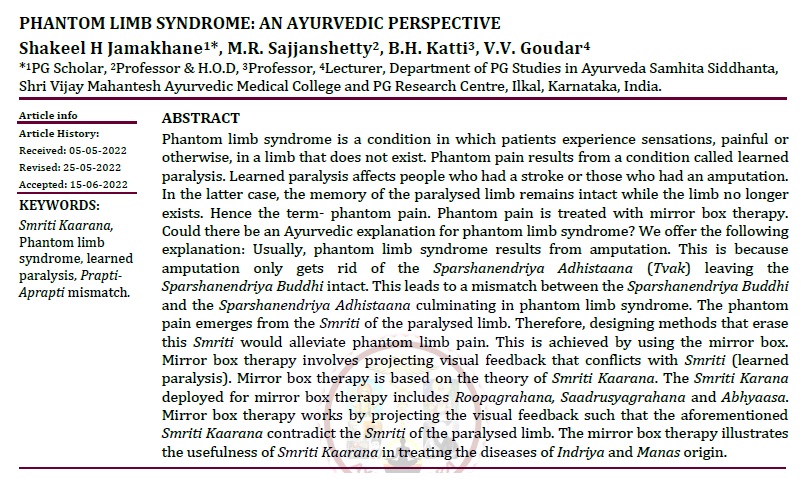Phantom Limb Syndrome: An Ayurvedic Perspective
DOI:
https://doi.org/10.47070/ayushdhara.v9i3.971Keywords:
Smriti Kaarana, Phantom limb syndrome, learned paralysis, Prapti-Aprapti mismatchAbstract
Phantom limb syndrome is a condition in which patients experience sensations, painful or otherwise, in a limb that does not exist. Phantom pain results from a condition called learned paralysis. Learned paralysis affects people who had a stroke or those who had an amputation. In the latter case, the memory of the paralysed limb remains intact while the limb no longer exists. Hence the term- phantom pain. Phantom pain is treated with mirror box therapy. Could there be an Ayurvedic explanation for phantom limb syndrome? We offer the following explanation: Usually, phantom limb syndrome results from amputation. This is because amputation only gets rid of the Sparshanendriya Adhistaana (Tvak) leaving the Sparshanendriya Buddhi intact. This leads to a mismatch between the Sparshanendriya Buddhi and the Sparshanendriya Adhistaana culminating in phantom limb syndrome. The phantom pain emerges from the Smriti of the paralysed limb. Therefore, designing methods that erase this Smriti would alleviate phantom limb pain. This is achieved by using the mirror box. Mirror box therapy involves projecting visual feedback that conflicts with Smriti (learned paralysis). Mirror box therapy is based on the theory of Smriti Kaarana. The Smriti Karana deployed for mirror box therapy includes Roopagrahana, Saadrusyagrahana and Abhyaasa. Mirror box therapy works by projecting the visual feedback such that the aforementioned Smriti Kaarana contradict the Smriti of the paralysed limb. The mirror box therapy illustrates the usefulness of Smriti Kaarana in treating the diseases of Indriya and Manas origin
Downloads

Downloads
Published
Issue
Section
License
Copyright (c) 2022 AYUSHDHARA

This work is licensed under a Creative Commons Attribution-NonCommercial-ShareAlike 4.0 International License.


